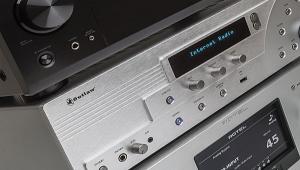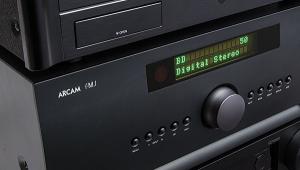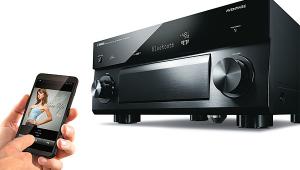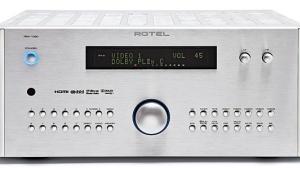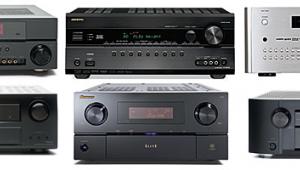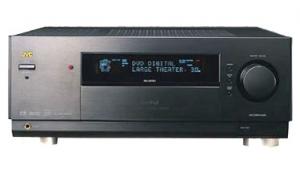HT Guide to AV Receivers Page 3
If you’re running five or more power-pig speakers full range, you may need more clean power than an A/V receiver can deliver. You’ll probably need a good multichannel amp. If you’re running a modest sat/sub set, almost any AVR will work, but a better one will give you less distortion and cleaner sound. You should exercise common sense and ask an A/V specialty retailer or custom installer for suggestions on speaker/AVR mating.
Video Processing: Cross-Conversion to HDMI
Many AVRs now convert all incoming signals for output through HDMI, so you can feed your display with one cable. This is certainly a desirable convenience feature, but its performance can be dicey. Some products do it better than others, and the fine print in the owner’s manuals for THX-certified A/V receivers often states that THX does not recommend such cross-conversion. It can be convenient, particularly for legacy sources. But don’t assume it will always produce the best picture quality. We check out this feature in the Video Test Bench section of Home Theater’s A/V receiver reviews.

Video Upconversion
Some AVRs add video processing, ranging from rudimentary to highly advanced, to convert signals to 1080p from other formats such as 1080i or 720p (broadcast TV channels) or 480i/p (DVD). Faroudja, Anchor Bay, HQV, and Gennum are among the better-known purveyors of video processing that’s used in AVRs. Video processing in AVRs may outperform what’s in your TV and disc player, so you should experiment to see which you prefer. But otherwise pristine HDMI passthrough is the bare minimum.
HDMI: The Key Interface
HDMI is the closest thing there is to a universal interface in current home theater systems. If you have an HDMI-savvy AVR and source components, it can make hooking up your system a lot easier.
Why HDMI?
HDMI isn’t always a free lunch. When they arise, compatibility issues among HDMI components are frustrating. But when your components play well together, AVRs with HDMI make switching easier in two ways. First, HDMI can carry audio as well as video from source components, which reduces the tangle of cables behind your equipment rack. Secondly, many AVRs now route all incoming signals through the HDMI output for easy one-cable connection to the video display.
HDMI 1.4/1.4a
As discussed above, HDMI 1.4 supports 3D, the HDMI Ethernet Channel, the Audio Return Channel, and the Micro HDMI connector. HDMI 1.4a offers additional 3D compatibility.
HDMI 1.3
Current A/V receivers now have HDMI 1.3 (and up), which offers the ability to process high-resolution multichannel PCM and onboard decoding for the latest lossless surround codecs. You’ll need at least the first to get the most out of a Blu-ray player, and you’ll need both if your player doesn’t internally decode the audio formats. HDMI 1.3 can pass all of the latest surround codecs as native bitstreams. Older versions of HDMI can carry some of them, but only 1.3 and higher will carry the lot, including Dolby TrueHD and DTS-HD Master Audio.
PCM Via HDMI
Why is it important for AVRs to process multichannel, high-resolution PCM via HDMI? First, because many Blu-ray Discs offer uncompressed multichannel PCM soundtracks. Second, because many Blu-ray players can convert Dolby TrueHD and DTS-HD Master Audio to this uncompressed audio format for output over HDMI. You’ll still get lossless audio, even from an AVR that doesn’t provide onboard decoding for the new codecs. This also allows the player to add secondary audio tracks to the mix.

Legacy Video Connectivity
While HDMI is the present and future of home theater, you’ll need other forms of connection to accommodate non-HDMI components.
Component Video
Like HDMI, this is a form of HDTV connection. It is analog and video only, but it’s high quality. If your AVR only has one HDMI output, component video may be handy for connecting a second monitor. You’ll find its color-coded red, green, and blue jacks on older HDTVs and DVD players. It’s helpful mainly if you’ve run out of HDMI jacks or run into HDMI compatibility issues. You’ll appreciate having the option in a pinch.
S-Video
This is an analog video connection that separates the brightness and color signals to avoid cross-color distortion. This mattered more in the pre-HD days but is less crucial now. S-video’s round multi-pin jack is not HDTV worthy and is disappearing from some AVR lines.
Composite Video
Composite video, which uses a yellow color-coded jack, is also not HD worthy. Composite video and S-video are used in Laserdisc players, VCRs, analog cable boxes, and other antediluvian signal sources. You might be better off pruning pre-HD sources from your equipment rack to the extent that’s possible. Some manufacturers are reducing or eliminating composite video and S-video connections on back panels.
Legacy Audio Connectivity
HDMI is the best way to carry audio signals. It’s the only digital interface that carries high-resolution multichannel audio (either as uncompressed PCM audio or native bistreams). Older signal sources require other kinds of audio connection.
Coaxial/Optical Digital
After HDMI, the next best choice is a digital connection that uses a coaxial or optical cable. There’s some controversy over which is better, but they’re roughly equivalent. You’ll find coaxial or optical digital outputs on DVD and CD players and various set-top boxes. We reiterate that neither coaxial nor optical digital connections are compatible with the next-gen, high-resolution audio solutions that are available on Blu-ray. However, they can transmit legacy (lossy) Dolby Digital and DTS.
Multichannel Analog Input
Sources that may require 5.1- to 7.1-
channel analog jacks include Blu-ray, SACD, DVD-Audio, and really ancient DVD players. This may bypass the AVR’s bass management and other settings, so use HDMI whenever possible. Note that if a Blu-ray player can decode high-resolution multichannel audio to analog, that multichannel analog audio can take advantage of Blu-ray’s advanced lossless audio functionality.
Multichannel Analog Output
Preamp outputs can be useful if you want to upgrade your system and use the AVR as a surround processor, along with a more powerful amplifier for some or all of the channels. The connection for powered subwoofers is usually included here.
Stereo Analog Input/Output
Audiocassette decks and other analog sources may require stereo analog jacks. A turntable requires a special phono input—otherwise you’ll need to add an external phono preamp.
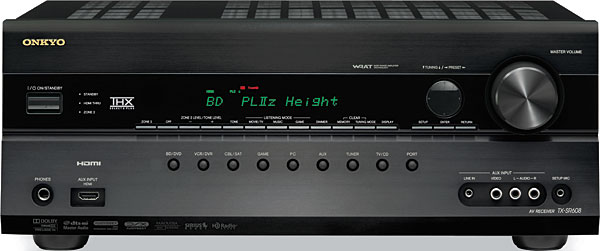
More Connectivity Options: Multizone Capability
Most AVRs include multizone capability (the ability to serve more than one room), multisource capability (the ability to process more than one source component), or both. Multizone video outputs are typically standard-definition S-video or composite video. Multizone audio outputs are typically stereo analog. Multizone is more for convenience than performance. Some A/V receivers include a second remote for multizone use.
Ethernet for Networking
A handful of A/V receivers connect to a router via Ethernet cable to get Internet radio or pull music, photos, and video off a PC. Some are certified by the Digital Living Network Alliance (DLNA). Others are certified for Windows Vista or Windows 7. AVRs may implement networked features without these forms of licensing, although capabilities vary. If your music library lives on a hard drive, you’ll want appropriate network capability. In addition, firmware updates have become a way of life, and Ethernet jacks that allow online updates are more convenient than other update methods. Of course, Wi-Fi Internet connectivity can be even more convenient, but it’s much less reliable than a wired connection for media streaming.
Sirius and XM
Many A/V receivers support either Sirius or XM satellite radio (they are now owned by the same company but maintain separate networks). The satellite radio antenna is usually a $20 extra-cost accessory. As an alternative, Sirius Internet Radio works through a network connection. Some XM channels come in discrete 5.1-channel XM HD.
iPod
Most AVRs include an iPod docking jack, which typically serves an optional proprietary dock. You can also buy generic iPod docks that plug into any analog input. A select few AVRs will accept the cable that came with your iPod, which allows a direct dockless connection.
USB and Bluetooth
USB is helpful for connecting external hard drives or thumb drives. A very select number of AVRs can also sense Bluetooth wireless devices.
Other
Additional connectivity options benefit custom and advanced installations. These include infrared remote jacks, to help the AVR accept commands when trapped in a gear closet; a 12-volt trigger, to activate other products like projectors, powered screens, power strips, and motorized curtains; and RS-232, for firmware upgrades or aftermarket control systems.
The User Interface: Onscreen Display
Although any A/V receiver challenges the user with a myriad of options, manufacturers vary widely in onscreen display (OSD) quality. Some models offer well-thought-out menus that are a pleasure to use, with full-color graphics and 3D-like diagrams for speaker adjustments. Others use dull monochrome graphics that make MS-DOS look like paradise. We are becoming increasingly disappointed in the latter, but ease of use still triumphs over razzle-dazzle.
Remote Control
Another issue is the remote. Unless you plan to upgrade to a fancy universal remote, you’ll want something with buttons that are well differentiated by size, shape, color, and layout. Many A/V receiver remotes include learning capability, preprogrammed command-code libraries, or both. They can therefore operate other components like your HDTV and disc player. Also, if you like to watch your movies in a darkened room, a remote that lights up on command will be a godsend.
Make a good decision on your A/V receiver, and you’ll be thanking yourself for years to come.
- Log in or register to post comments
